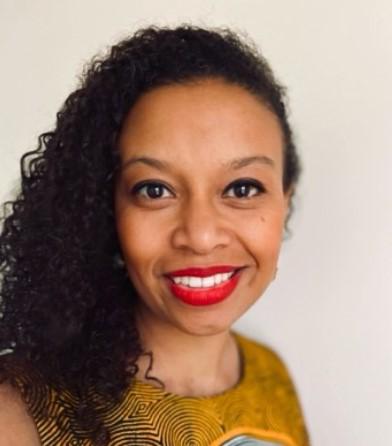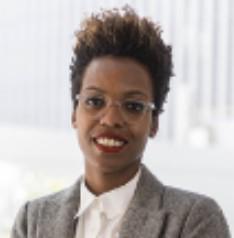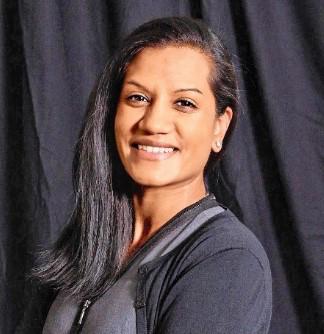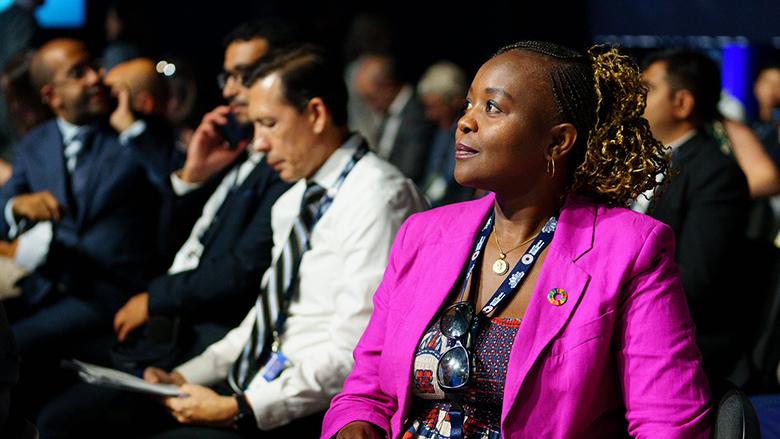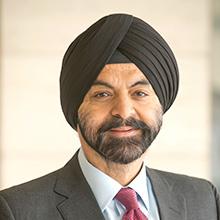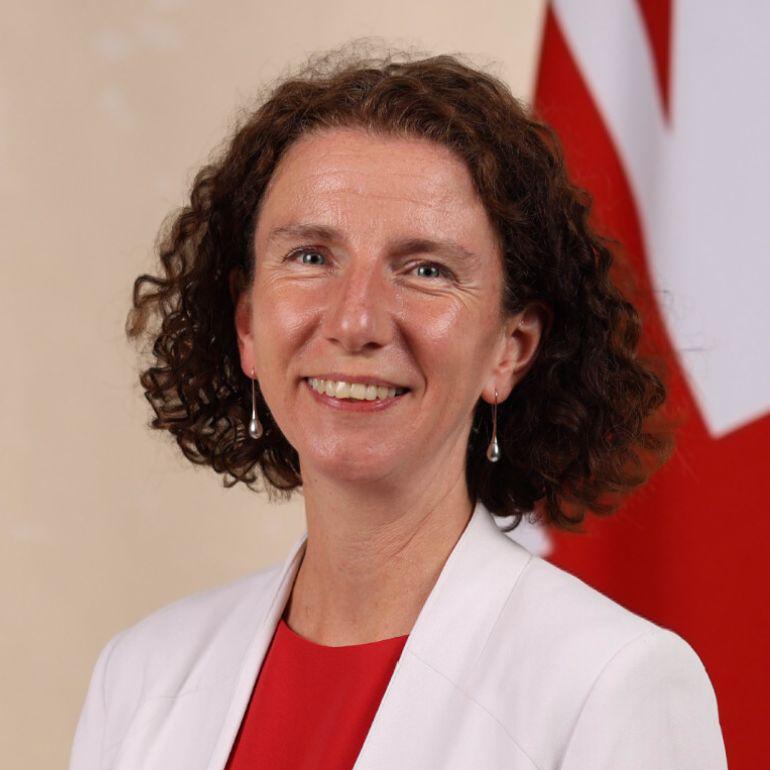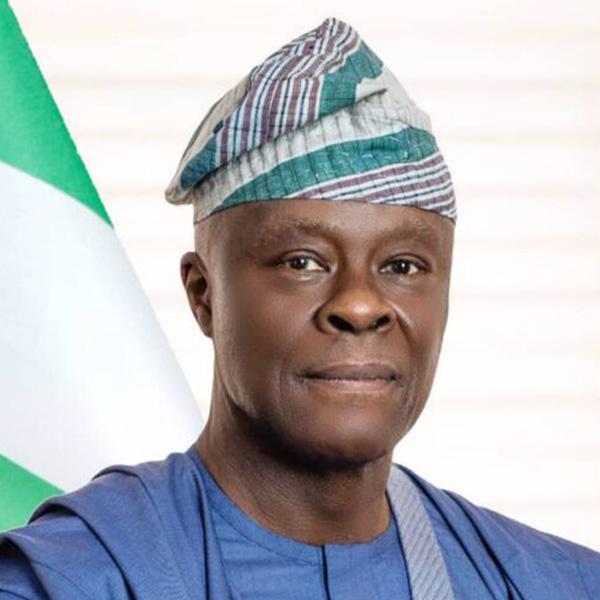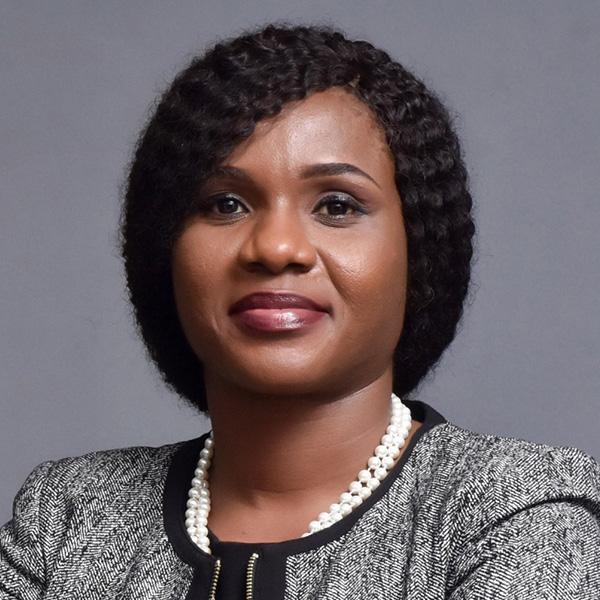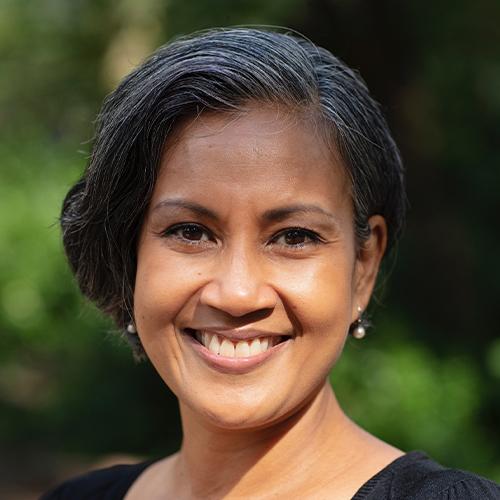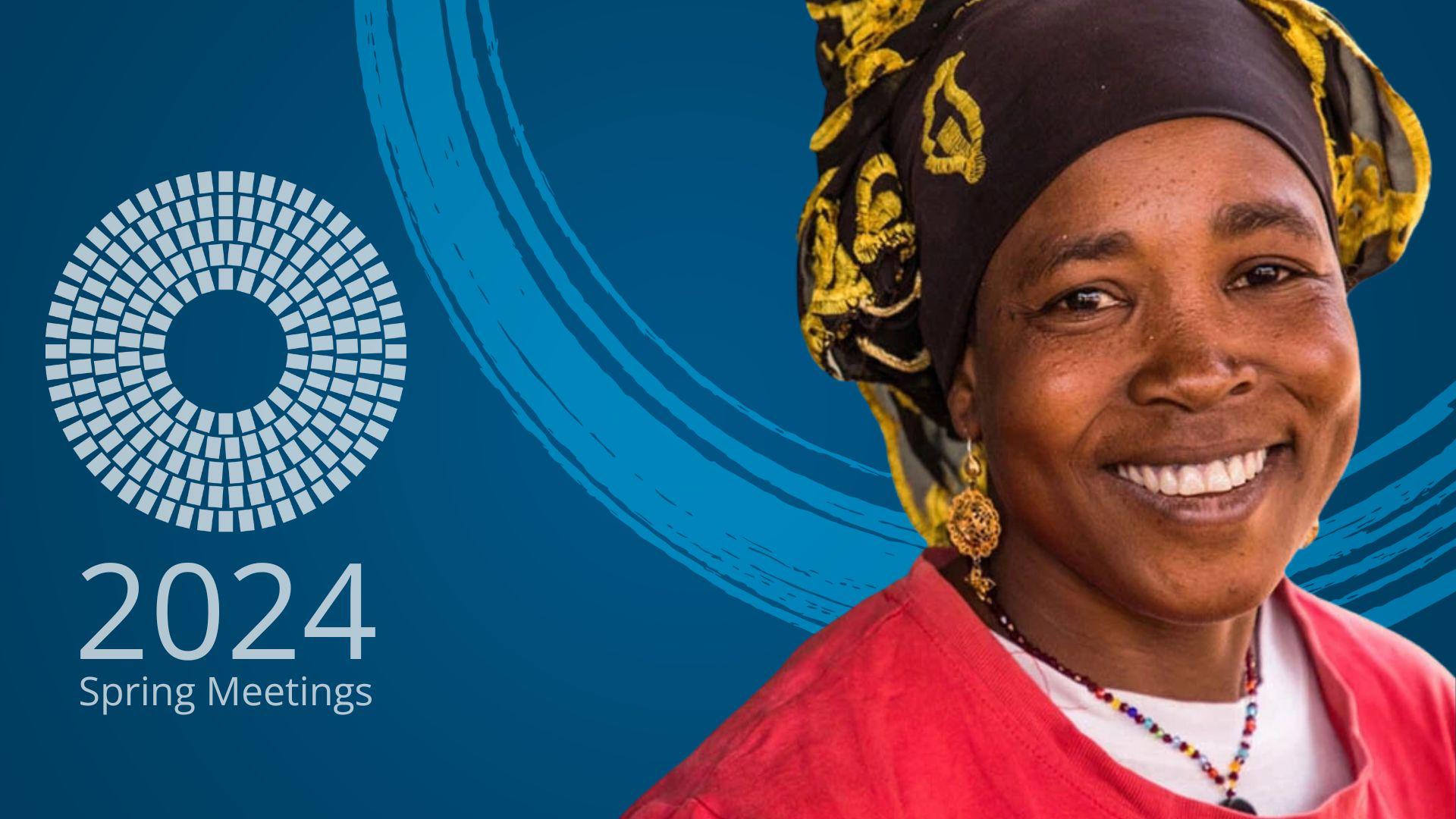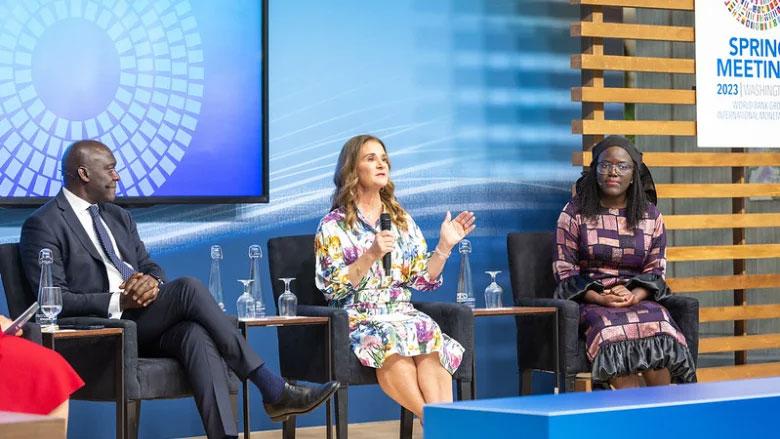Welcome everyone! I am Erick Rabemananoro, and I will be moderating the online discussion today. I will be providing updates and highlights from the event and sharing resources on the topic at hand.
Moderator: Erick Rabemananoro
I am joined by four expert live bloggers who will answer questions during the event: Alicia S. Hammond, Priyanka Tayal Kolasa, Elizabeth Mensah, and Yasmine Sampomaa Acheampong.
Moderator: Erick Rabemananoro
Our event is moderated by Shakuntala Santhiran, Shaks for short. She is an international broadcast journalist, professional moderator, and MC. She has more than two decades of experience as a television news anchor, reporter and producer with leading media organizations including the BBC, CNN International and Al Jazeera English.
Moderator: Erick Rabemananoro
The panel includes Ajay Banga, the World Bank President, Adebayo Olawale Edun, Finance Minister from Nigeria, Sandra Ablamba Johnson, Planning Minister and General Secretary at the Presidency from Togo , and Anneliese Dodds, Minister for Development, Women & Equalities from the United Kingdom.
Moderator: Erick Rabemananoro
By 2030, the WBG will boost economic opportunities for women by equipping 300 million more women to use broadband internet, supporting over 250 million more women with social protection programs, and providing 80 million more women and women-led businesses with capital.
Moderator: Erick Rabemananoro
In your view, what do you see as the most significant barriers preventing women from entering and advancing in the workforce, particularly when it comes to gender discrimination in hiring and promotion? How can organizations better address these challenges to foster more equitable opportunities for women
June Lutchman
Gender gaps in labor force participation persist worldwide. Closing this gap can lead to sizeable gains for economies—a 20 percent increase in GDP per capita, on average. Women comprise a growing share of the skilled workforce and bring diverse perspectives that fuel innovation and deliver results. However, female labor force participation (FLFP) remains low due to lack of skills, assets and networks, time-based constraints, limited mobility, gender discrimination in hiring and promotion, and restrictive gender norms. The World Bank Group actively works with the public and private sector in boosting FLFP through development policy lending and investments, advisory and analytical work, and supporting reforms to address constraining contextual factors, including legal barriers, social norms, care, and gender-based violence. You can read more about the WBG’s approach to increasing FLFP here: tinyurl.com/yv7kb3kc
Expert: Priyanka Kolasa
Financial institutions can play a significant role in helping women overcome financial difficulties and boost their businesses by revising traditional lending criteria and offering more accessible, inclusive financial services. Here are several ways they can achieve this:Flexible Lending Criteria
Tailored Financial Products
Financial Literacy and Training
Digital Financial Services
Targeted Investment Funds
Promoting Inclusivity and Equity
Peer-to-Peer Lending and Crowdfunding
Christine
The World Bank Group is committed to engaging with Financial institutions to close this gap. For example, MIGA’s clients have committed over 1.4 billion dollars to women and women owned businesses in the last 3 years, and have collaborated with IFC’s Banking on Women business to support gender intelligence training, workshops to design gender value propositions, and define minimum viable products for women. Since 2012, IFC’s Banking on Women business tinyurl.com/97rb9wfm has mobilized and invested $8.6 billion in emerging market financial institutions to finance women entrepreneurs and micro, small, and medium enterprises owned and led by women of which $5 billion were specifically for Women owned or led SMEs. In FY24 nearly $1 out of every $5 that FIG invested was earmarked for women and women-led MSMEs. IFC has helped 11 financial institutions launch Gender Bonds in 8 countries, and has invested over $1 billion in housing finance for women. You can read more here: tinyurl.com/m95wajcm and here www.miga.org/gender
Expert: Elizabeth Mensah
What lessons can the WB share on influencing major non-gender programs to increase WEE and gender lens investing?
Leisa Gibson
Thank you for the question. There is wide consensus that women entrepreneurs are less likely to gain access to financial services than men, such as credit and equity financing, insurance, and savings. WBG is approaching this through targeted interventions that improve access to skills, finance, markets and technology while also tackling contextual constraints. You can read more about the WBG’s approaches for supporting women-led business here: tinyurl.com/4hk4yhfa As an example, IFC works with its partner funds, accelerators, and investee companies to implement targeted interventions aimed at increasing gender equality and supporting gender-lens investing across sectors and markets. Learn more: tinyurl.com/nf9ebvt3
Expert: Priyanka Kolasa
It is great to hear these ambitious targets.
Gaurav
We need more woman on Boards. How do we achieve this?
Teresa
Thanks for this important question. Indeed, as per a 2023 study, women hold only 23.3 percent of board seats and 8.4 percent of board chair positions. Approaches to compel change include approaches such as quotas and targets, transparency and reporting requirements, corporate governance codes, and investor activism. The WBG is supporting women’s leadership and decision-making, including through the IFC’s Women on Boards and in Business Leadership program. You can read more about WBG’s approach towards increasing women’s representation in business leadership, including on Boards, here: tinyurl.com/37tex5w6
Expert: Priyanka Kolasa
What are the most suitable ways to break the prevailing barriers supporting women underserved communities.
Angonimi David-Imeh
Thanks for this important question. Supporting women in underserved communities is essential to accelerating gender equality across the world. Women in underserved communities face multiple constraints that heighten their vulnerability and interventions to support them must be holistic and sustainable. Interventions may include: providing financial resources to support women’s entrepreneurship and employment; changing laws that expand women’s ownership and control of land; improving access to safe transport and care services. These programs could also be complemented by interventions to end GBV, enhance skills, and engage women in community decision-making.
Expert: Yasmine Acheampong
Diversity, equity and inclusion is occupying the discuss on the table and especially it is shaping investment decisions of major stakeholders. Stakeholders are getting all the more engaged in DEI, from the formation of board members, to employees and to business localization. Parallelly the variables of diversity is increasing, ranging from the more obvious such as gender and the salient ones such as women with disabilities, women returning to careers after a long break from worklife due family situations such birth or caring for a family, peculiarity of women of third world and African countries etc. Sometimes non-inclusivity could be a perception or could be passive, how is the WBG ensuring the right space in ensuring DEI so as no one is left behind, what are the work place values the WBG has in dealing with salient variables of diversity, what is their visibility and instrument of exchange when it comes to institutionalization of DEI
Martha_Damina
Thank you for this important question on Diversity, Equity and Inclusion. Indeed, workplaces benefit from greater DEI in numerous ways. For example, we know that companies with more gender 0diverse leadership demonstrate a stronger commitment to inclusive growth, broader stakeholder focus and good ESG Practices. This is why the WBG Gender Strategy has prioritized these three objectives: (1) end gender-based violence and elevate human capital, (2) expand and enable economic opportunities, and (3) engage women as leaders. You can learn more about our gender strategy here: tinyurl.com/2awn7rau.
IFC and MIGA work to reduce gaps between women and men in the private sector, enabling companies and economies to improve their performance. You can read more about work with the private sector here tinyurl.com/2p8j8r5h and tinyurl.com/bdeuy6nn
Expert: Priyanka Kolasa
What real world initiatives can be instituted so that women can feel encouraged to join the workforce more in the societies where taboos and gender-based discrimination predominates the professional domains and workforce hierarchy?
Tashfiya
Thanks for your question. Indeed, social norms that encourage gender-based discrimination, restrictive laws and policies and time pressures constrain women’s participation in the workforce. Increasing women’s labor force participation requires interventions that address multiple barriers. Promising interventions include provide affordable childcare, parental leave and flexible workplace policies, providing safe and secure transportation, implementing anti-harassment interventions and providing jobs and skills training programs. This thematic policy note provides additional information on WBG’s approach for increasing female labor force participation: tinyurl.com/yv7kb3kc
Expert: Yasmine Acheampong
There is a further level to the glass ceiling added by AI - fake jobs are being increasingly posted to job boards to pad the volume. Is there any study being done to see how this affects women and how can this be combatted.
June
Thank you for this very interesting question! The rapid rise of generative artificial intelligence is affecting all sectors and changing the skills needed to succeed in the job market. In fact, AI is projected to impact nearly 40% of global employment. Research from PEW indicates that a larger share of women’s jobs will be affected by AI, largely because of the types of roles they occupy.
This great blog from our Education colleagues might be of interest: tinyurl.com/ywdwc62h
Expert: Alicia S Hammond
Education for the girl child is the most cost effective tool for accelerating gender equality and empowerment. Why is free and , functional education for the girl child not fully supported and funded in the developing countries apart from periodic declarations and statements of intentions
Undelikwo
Thank you for this important question. Quality education is essential to elevating girls’ human capital, reducing poverty and improving global outcomes. The World Bank is the largest external financier of education globally, and the largest investor in girls’ education. Our programs go beyond getting girls into school, they also ensure that they are able to learn and feel safe while in school, have the opportunity to complete all levels of education, acquire knowledge and skills to enter the labor market. For example, the East Africa Girls Empowerment and Resilience project supports over 2 million girls to remain in or return to school, the Nigeria Adolescent Girls Initiative for Learning and Empowerment project addresses constraints to girls’ education and empowerment. This policy note provides more information on how we are supporting girls’ education: tinyurl.com/3xrazcdu
Expert: Yasmine Acheampong
How can we ensure that policies aimed at boosting women’s economic opportunities are effectively implemented across diverse global contexts to accelerate equality and contribute to sustainable development?
Sabina Pradhan
Thank you for the question. It is certainly true that context matters when identifying and promoting economic opportunities for women. The World Bank Group Gender Strategy will be implemented in line with its country-led engagement model, which recognizes that countries face heterogeneous challenges and have differences in policies and legal frameworks. This engagement model will help to provide robust data and analytics and enable knowledge and learning exchange with partners across the public and private sectors. You can read more about how the WBG will engage through its new gender strategy here: tinyurl.com/2awn7rau
Expert: Elizabeth Mensah
Economic participation of women remains a challenge, The Women Economic Assembly aims to facilitate economic participation of women , through the supply chains of industry, I.e. being deliberate and targeted about creating opportunities for women owned business to be suppliers . What catalytic role can the World Bank play to facilitate this agenda.
Futhi Mtoba, CO-Chair, Women Economic Assembly
Thanks for the question. Indeed inclusive supply chains facilitate greater access to opportunities and to accelerate the growth of women entrepreneurs and enabling them to better participate in and benefit from economic opportunities throughout the value chain. This includes supporting the growth of women-owned/-led suppliers, distributors, and retailers, and investing in women’s employment and leadership across the supply chain. It also includes supporting low income and underserved individuals to access goods and services or integrate into supply chains as entrepreneurs. For example, IFC’s Sourcing2Equal Global Program seeks to connect thousands of women entrepreneurs to new market opportunities via corporate procurement: tinyurl.com/47kxkk44
Expert: Priyanka Kolasa
How do we ensure that women and girls are financially literate, so that they are financially stable, if they ever are subjected to economic/financial abuse?
A.D.A Against Domestic Abuse
Tailored approaches are needed to increase women’s financial literacy and digital skills, expand their use of financial and digitally enabled services as well as improve their access to capital, networks, markets and entrepreneurial ecosystems To support financial institutions in addressing financial abuse, IFC recently launched 'Empower Finance' to share information and best practice and introduce the tools and solutions to better protect customers and financial institutions: tinyurl.com/4wym6knc
Expert: Priyanka Kolasa
Why is there becoming a focus on norms when the laws and regulations do not provide a level playing field for women when it comes to basic rights, identification docs, financial services, education, etc. etc. Are leaders afraid of saying we need a level playing field?
R
Thanks for your question. Achieving gender equality requires us to address inequalities more holistically, and this includes understanding and addressing attitudes and social norms that perpetuate inequality, e.g harmful practices such as child marriage, female genital mutilation etc. Changing laws and policies to provide a level playing field for women is essential, however, they can only be effective if we also focus on interventions that change behaviors and attitudes. Social norms and laws go hand in hand – to successfully enforce legal frameworks, we need to also change social norms otherwise we might see a reversal of gender equality across different sectors. Our thematic policy note on social and gender norms may provide more insight on the role of norms in promoting gender equality: tinyurl.com/yxbn6ek8
Expert: Yasmine Acheampong
Gender issues have been there from as long as I can remember, even in my household when my grandfather would say this is a girl's job and not let the boy's clean kitchen utensils or take out the trash, etc.. I would say the problem stems from family values and should be corrected from there as girls always seem to be the lesser valued. Even in exchange of names because the male is the dominant figure. So, this carries on to the work environment. Please share your opinion on this. Thank you.
Gillian Andrina Gregoria Polius
Many thanks for your question. Achieving gender equality certainly has a personal dimension and requires changes to our personal lives, including changes to attitudes, beliefs and behaviors that are harmful to women.
Expert: Yasmine Acheampong
How do we prevent Domestic Abuse, a crime that affects women, disproportionately and is rooted in gender inequality?
A.D.A Against Domestic Abuse
Thanks for this important question. Gender-based violence (GBV) is the most egregious manifestation of gender inequality, and the WBG Gender strategy aspires to end all forms of GBV. Addressing GBV requires collective action at the national and local level to challenge harmful gender norms, support GBV survivors, empower women and adolescents, and dismantle patriarchal systems. You may read more here to learn more on how we support GBV prevention and response in our operations: tinyurl.com/2hfajb4c and tinyurl.com/5e6yx992
Expert: Yasmine Acheampong
Good morning, there are so many social identities: gender, socio-economic groupings, disability etc. Is anyone looking at the intersection of these social identities? This is necessary because some social identities are more likely to coincide, for example, a disabled woman is more likely to be from a lower socio-economic group. So by including disabled women, we may be able to address poverty and impairments...as Ajay Banga might say walking...And chewing gum at the same time. I am a disabled woman, researching in the area of disabled women and climate change...please could you do your best to include disabled women who are best-placed to discuss issues pertaining to disabled women? Thank you, Elizabeth
Elizabeth
Thanks for this important question. Indeed, there is a strong intersection between gender and characteristics such as poverty, disability, and ethnicity. For example, only one-quarter of economies worldwide explicitly recognize the rights of women with disabilities. The WBG Gender Strategy recognizes that these intersections can heighten vulnerability, and reaffirms the WBG’s commitment to nondiscrimination, inclusion, and equality of opportunity. Achieving gender equality entails ensuring that all people, no matter their gender identity and characteristics, have equal rights and opportunities
Expert: Yasmine Acheampong
In my opinion, it is important to rethink the creators of the digital divide as communities are now gradually becoming aware of the benefits of digitalization and digital inclusion. Thus social and cultural norms and barriers that traditionally inhibited women’s inclusion in digitalization is incrementally being broken down. I strongly believe technology itself is creating a new divide the is threatening to leave the unconnected and underserved further behind.
Abena Nyamesem
This is absolutely a warranted concern. Digital technologies are transforming economies, creating jobs, and improving lives. However, the digital divide remains sizeable and is increasingly linked to broader development gaps. For instance, the latest data from the ITU suggests that there are 244 million more men than women using the Internet.
There’s also a considerable difference in internet use between low-income and wealthy countries. To address this, we need to focus on improving access to the internet, increasing smartphone and computer ownership, expanding fixed broadband availability, boosting internet speeds, and enhancing digital skills. It’s crucial to work on these areas to ensure everyone can benefit from digital technologies.
Read more in the Digital Progress and Trends Report: tinyurl.com/3whf2sp3
Also, you might find IFC’s Digital2Equal program of interest: tinyurl.com/47kxkk44
Expert: Alicia S Hammond
How and what can be done to bring gender equality?.
Nko prudencia
Thank you for this important question. Achieving gender equality and ensuring that nobody is left behind is a complex and challenging objective that requires the collective action of a wide range of stakeholders across the public and private sectors. Our new gender strategy prioritizes 3 strategic objectives that we believe will accelerate gender equality to end poverty on a livable planet. They are: (1) end gender-based violence and elevate human capital, (2) expand and enable economic opportunities, and (3) engage women as leaders. You can learn more about our gender strategy here: tinyurl.com/2awn7rau
Expert: Yasmine Acheampong
Why is it difficult most at times for women to be giving some top positions in the company or organization.
Nko prudencia
Thanks for your question. You’re right, there is a gender gap in women’s leadership in the public and private sectors. Globally, women hold only 5 percent of CEO, and 15.7 percent of CFO positions. There are several reasons that limit women’s professional aspirations and narrow leadership paths, including lack of training and professional development opportunities, gender biases and stereotypes, and other workforce barriers. Addressing women’s leadership will require proactive approaches to expand women’s participation in decision-making across the public and private sectors. To increase the number of women leaders and prepare them to take on leadership roles, companies and organizations must invest in women. The WBG is supporting women’s leadership, including through the IFC’s Women on Boards and in Business Leadership program. You can read more about increasing women’s representation in business leadership here: tinyurl.com/37tex5w6
Expert: Priyanka Kolasa
How do we get Big Tech to take online safety seriously for users in the global south, a factor that has been proven to alienate instead of onboarding more women into digital platforms.
Carol Ndosi
Thank you for your important question! As more women come online, the risk of online violence unfortunately rises. The issue of technology-facilitated gender-based violence is not well-researched, especially in low- and middle-income countries.
However, some promising approaches are emerging: To tackle this, countries in the Global South can collaborate with local communities to pinpoint specific online safety concerns. They can also include online safety training in digital literacy programs and explore policies to reduce technology-facilitated gender-based violence. Importantly, teaching healthy online behaviors is essential for everyone, not just women, to create a safer internet for all users.
This brief from the World Bank’s Solutions for Youth Employment team provides a helpful overview of available data, key definitions, and promising solutions: www.s4ye.org/node/4072
Expert: Alicia S Hammond
Ensuring that no woman is left behind in our pursuit of a livable planet requires a multifaceted approach. What specific strategies or initiatives do you think are most effective in achieving this goal?
Lucky Taderera
Thank you for this important question. Achieving gender equality and ensuring that nobody is left behind is a complex and challenging objective that requires the collective action of a wide range of stakeholders across the public and private sectors. Our new gender strategy prioritizes 3 strategic objectives that we believe will accelerate gender equality to end poverty on a livable planet. They are: (1) end gender-based violence and elevate human capital, (2) expand and enable economic opportunities, and (3) engage women as leaders. You can learn more about our gender strategy here: tinyurl.com/2awn7rau
Expert: Yasmine Acheampong
How can empowering women economically not only bridge the gender gap but also drive sustainable development and eradicate poverty on a global scale?
Lucky Taderera
Thank you for the question. We cannot end poverty on a livable planet when half the world’s population is excluded from opportunity. When women thrive, countries and communities thrive. Income per capita would be almost 20% higher if women were employed at the same rate as men. Women are also essential for driving inclusive and effective responses to climate change. Because they are disproportionately impacted by the climate crisis, they are at the forefront of developing climate solutions that address their needs and the needs of their communities. Women’s presence in local climate change responses is associated with better resource governance, conservation outcomes, and disaster readiness. Furthermore, women’s presence in leadership, including in government and in the private sector, is associated with better sustainability outcomes. In short, empowering women is critical to driving sustainable development, addressing climate change, and eradicating poverty. You can read more here: tinyurl.com/4wj439ke and here: tinyurl.com/55sus8sp
Expert: Elizabeth Mensah
What measures have been implemented so that women do not have to neglect their careers because they are not compatible with their role as caregivers?
Heromina
Thanks for your question. Indeed, women’s labor force participation is significantly impacted by care responsibilities. Interventions to address care needs and improve women’s labor force participation may include: job-protected parental leave, access to quality and affordable childcare, paid family leave and employer-supported childcare and family-friendly workplace policies and practices.
You can read more about the WBG’s approach to addressing care to accelerate gender equality: tinyurl.com/mstxxmav
Expert: Yasmine Acheampong
How does the world, filled with so many cultures form a uniformed law that doesn't undermine the role of woman in society. We know across certain cultures the woman is deemed subservient. This plays out in gender based violent crimes and how authorities respond to it? What is your views?
Estelle Wadsworth
Thanks for your question. Cultural and social norms around the world perpetuate stereotypes and biases that reinforce gender inequality. Achieving gender inequality will require changes to laws and policies, behaviors and norms, public and private sector activities, and personal lives. Measures to address harmful social norms include community outreach, working with men and boys to challenge masculinity stereotypes and introducing teaching and learning materials that tackle gender biases. Increasingly, our operations are addressing social norms in their operations. You can find out more on addressing social and gender norms to promote gender equality: tinyurl.com/yxbn6ek8
Expert: Yasmine Acheampong
How can women participate effectively with the poor educational and skill accusation support from their male parents (i.e. the Middle East, Africa, and other parts of the world)?
Maisamari Mathias John
Thanks for your question. Achieving gender equality requires everyone’s involvement. Involving fathers, male leaders and boys across the community can help reframe their perceptions and foster their support and buy-in for gender equality. Men and boys can play a critical role as champions to change attitudes about gender equality and address harmful masculinity.
Expert: Yasmine Acheampong
I appreciate how you take time and resources to try to empower rural women. However l still feel the gap in trying to empower them seems unfruitful because they are not linked to the correct markets in selling their produce. technologically they are cut out from the reliality of how the economy will be operating also they have little or no esucation. How can this be solved because its been years these projects are carried out and the results are not clear.
Violet
Indeed, rural women often face unique challenges accessing economic opportunities. As part of the consultations for the WBG Gender Strategy, we heard from both urban and rural women about the challenges they face. The strategy promotes economic participation for all, recognizing that approaches will need to be fit for purpose depending on the context. In poor rural areas, for example, this might mean combining programs that support women’s productive economic participation and entrepreneurship and those that expand women’s ownership and control of land and smartphones, with access to safe transport and care services. These would be complemented by interventions to end GBV, enhance skills and SRHR, and engage women in community decision-making.
You can read more about this here: tinyurl.com/6zj64zbf and here: tinyurl.com/yeyyd2nf
Expert: Elizabeth Mensah
With the need to accelerate gender equality the question that begs to be answered is how to mitigate the effects of climate change that tip the scale to women being the group that is more disadvantaged, how do we empower the women and the community at large
Euliana
Indeed, women and disadvantaged groups are disproportionately impacted by climate change and gender gaps could widen in the context of the climate transition. This is because the sectors receiving the most climate capital and generating the most jobs, are also the sectors where women are least represented in the workforce and in leadership. This is not just bad for gender equality, it also prevents us from effectively managing the climate crisis and developing effective and inclusive solutions to address it. Women’s presence in local climate change responses is associated with better resource governance, conservation outcomes, and disaster readiness. Women’s presence in leadership, both in the public and private sector, is associated with better climate outcomes for governments and companies. This WBG thematic policy note provides more information on how we can place gender equality at the center of climate action: tinyurl.com/mry6r2p2
This IFC discussion note talks about the potential and challenges of supporting women-led climate businesses: tinyurl.com/thdb8act
Expert: Priyanka Kolasa
What is the system in place or methods of checking if the planned and implemented ways to promote the boosting women’s economic opportunities can transform our world, that have in previous similar methods work or not worked not in data but pragmatical in the field. If it actually works by checking on the progress of the women.
RENNY
Thanks for your question. The World Bank’s Gender Innovation Labs (GILs) conduct impact evaluations to assess the outcome of development interventions and generate evidence on how to close the gender gap in earnings, productivity, assets, and agency. You can find out more about GILs here: tinyurl.com/3duvyv7x
Expert: Yasmine Acheampong
What mesures will you put in place to boost women’s economic opportunities which can transform our world
Alleria Bruce
Thanks for your question. Indeed gender equality and women’s economic empowerment are essential for development and contribute to sustainability and resilience as well as to economic growth, productivity, and poverty reduction. The new WBG Gender strategy reflects a strategic objective on expanding and enabling economic opportunities through the public and private sectors. This includes addressing the nexus of access to more and better jobs, economic assets, and enabling services (such as care) that expand economic choice. You can read more about the WBG’s approach on expanding and enabling economic opportunities: tinyurl.com/2awn7rau
Expert: Priyanka Kolasa
Can you comment on impact measurement and which, in your opinions, has been the most impactful program targeted to boosting women economic opportunities?
josetche
Thanks for your question. The World Bank’s Gender Innovation Labs conduct impact evaluations to assess the outcome of development interventions and generate evidence on how to close the gender gap in earnings, productivity, assets, and agency. You can find out more about GILs here: tinyurl.com/3duvyv7x
Expert: Yasmine Acheampong
What is the world Bank doing in terms financing women in digital inclusion
Wirimo
Thank you for your great question! The World Bank Group is actively working to promote digital inclusion. We focus on helping women and girls access and use the Internet and other digital services. We’re also committed to making sure that affordable devices and data are available to women, people with disabilities, young people, and more. Additionally, we support initiatives that improve digital literacy.
It's crucial that both the public and private sectors work together to ensure digital technology meets the needs of women and helps empower them economically.
You can read more about WBG’s approach to increasing access to technology for inclusion here: tinyurl.com/3zffu2jk
Expert: Alicia S Hammond
It is a well-known adage that men often advance in their careers and businesses through the ‘old boys’ network. How can women effectively tap into these networks or create their own?
Susan Dambudzo Martha Bvochora
Supporting women’s employment and leadership is a cornerstone of the WBG Gender Strategy 2024-2030. For example, IFC works with private sector partners to create more and better opportunities for women to earn a livelihood, by enabling access to more and better jobs and leadership roles. IFC’s She WINS Arabia program has built the skills and networks of more than 80 women entrepreneurs and increased the capacity of fund managers and accelerators to target, support, train, and invest in women-led startups and enterprises. Another example of supporting women in leadership is MIGA’s flagship Gender Leadership Award (GLA). The GLA recognizes leaders who have worked with MIGA and who have shown a strong commitment to advancing women's empowerment and gender equality. You can read more about these efforts here www.miga.org/gender, here: tinyurl.com/37tex5w6 and here: tinyurl.com/3mpxc9uy
Expert: Elizabeth Mensah
Kindly share more on the Cross-sectional relationship between gender and climate change
Hilda Mahumucha legal Consultant Zimbabwe
Many thanks for your question. Women and disadvantaged groups tend to be more affected by climate change across various dimensions, including health, livelihoods, and agency, and promoting sustainable development requires addressing both gender equality and climate change together. In addition to the disproportionate impact of climate change on women, women are also more likely to be left out of climate-related opportunities, for example access to new green jobs and access to climate finance to advance their businesses in more sustainable ways. Finally, women are important agents of change to develop and implement climate solutions that are effective and inclusive for their households and communities.
You can read more here to learn how gender and climate change are linked: tinyurl.com/mry6r2p2
Expert: Yasmine Acheampong
How do we empower the girl child to be competitive and take up STEM courses?
Sithandekile
This is a great question—it is very important to support the participation of women and girls in STEM. Gender stereotypes and biases are especially strong drivers of gender gaps in STEM. To better support girls, there is a lot we can do: We can correct gender biases in learning materials and in the classroom; help expose girls to hands-on STEM extracurricular activities; and connect girls with female role models to build their self-efficacy, among many other solutions.
This is a blog that provides a nice summary: tinyurl.com/2mbvtejr
Also an IFC study done with Coursera has some interesting findings about how to boost women’s participation in STEM courses online. Read about it here: :https://tinyurl.com/3bkway9c
Expert: Alicia S Hammond
how can we help advocating for gender equality in communities where there lack of access to financial resources?
Sharon Chinkalamba
Thanks for your question. Financial inclusion is integral to achieving gender equality and expanding women’s economic opportunities. In poor rural areas, achieving gender inequality could combine programs that support women’s entrepreneurship and those that expand women’s ownership and control of land, with improved access to safe transport and care services. These programs could also be complemented by interventions to end GBV, enhance skills, and engage women in community decision-making. The financial sector also recognizes that women form a valuable, large and growing market that presents significant economic opportunities. You can read more about the WBG’s approach to accelerating gender inequality: tinyurl.com/2s3tp9xj and tinyurl.com/4hk4yhfa
Expert: Yasmine Acheampong
Hi,I am Doris from Liberia. Thank you all so much have great interest in women.
Doris Mamie Noltze Devine
Hello Doris, thank you for joining our session, your participation is greatly appreciated!
Moderator: Erick Rabemananoro
Gender inequality still exist in South Africa how can this gab be closed?
Thuli
Thanks for your question. There has been significant progress around the world to address gender inequality, however, gender inequality still exists due to crises, conflict, and global trends such as climate change which exacerbates inequalities. Addressing gender inequality requires a strong commitment to changing laws and policies, social norms, public and private sector activities, and personal lives. You can read the WBG Gender Strategy to learn more on accelerating gender equality: tinyurl.com/yeyyd2nf
Expert: Yasmine Acheampong
What role does the World Bank play in influencing individual country policies? If the narrative changes from policy level it will then influence corporates and community structures.
Kelebogile
Many thanks for your question. Policies are essential to achieving gender equality. The World Bank engages in policy dialogue and supports countries to implement institutional and policy reforms that address gender constraints. Examples of the World Bank’s policy support include development policy operations to support GBV, reduce hiring discrimination, and improve women’s access to assets. The Albania Gender Equality in Access to Economic Opportunities DPF - tinyurl.com/3htnrfbd is an example of our support for policy reforms.
Expert: Yasmine Acheampong
The most undoing in this global discourse are the women triple roles. How has thi been treated and what is the new thrust in this regard?
Denford
Women’s triple roles disproportionately impacts their time and ability to complete school, obtain paid work, and dedicate time to establish or grow businesses. The WBG is expanding access to quality, affordable childcare; improving girls' education, learning and empowerment; providing access to capital and better jobs; and investing in infrastructure, including access to water, sanitation, energy, transport, and healthcare to reduce the time spent on care responsibilities. The new WBG Gender Strategy responds to the global urgency, fundamentality, and complexity of achieving gender equality: tinyurl.com/2hcehfyt
Expert: Yasmine Acheampong
How does World Bank encourage third world countries to ensure access to skills & education now, especially with A1 taking the work space where most jobs are to be automated in workplaces?
Maredi
Ensuring that people in low and middle-income economies have the skills to participate fully and equitably in the digital economy is essential to inclusive development. This challenge has become even more urgent with the advances in artificial intelligence. Governments are formulating AI strategies to accelerate safe and inclusive AI adoption, with a focus on building infrastructure, developing advanced/specialized digital skills, and adopting AI solutions.
Visit our Digital Progress and Trends Report (Chapter 5) for more details: tinyurl.com/jx5cbxzs
Expert: Alicia S Hammond
Why women are being descrimite at work especially when they are the leaders?
Vuyiswa Duma
Thanks for your question. Harmful social norms, stereotypes and biases are can limit women’s professional aspirations and narrow leadership paths. To help address this, the new WBG Gender strategy reflects a strategic objective on engaging women as leaders in the public and private sectors. Through our operations, we support women’s participation in decision-making at the national and sub-national levels as well as in business leadership, and education and employment in male-dominated sectors such as energy and technology. You can read more on the WBG’s efforts on increasing women’s representation in business leadership: tinyurl.com/37tex5w6
Expert: Yasmine Acheampong
Lack of child care and lack of child support impeads economic benefits of working as most of ingle mothers income is spent on provision which impacts on their latter years. Single mothers get a negative credit ratings die to fathers not paying child support, paying less ot not on time. The impacts have dire consequences for women as they are unable to secure mortgages, rentals, credit and sometimes enjoyment.
Felicity Guest
Thanks for your question. Indeed, the lack of quality and affordable childcare impedes women’s economic participation and affects their overall well-being. Through our operations we are expanding access to quality, affordable childcare by leveraging existing community health or nutrition programs, and integrating childcare into entrepreneurship or skills training programs to create jobs for women, and supporting employer-supported childcare. You can read more on the WBG’s efforts to address care: tinyurl.com/mstxxmav
Expert: Yasmine Acheampong
Liberia is poor Country. SGBV is high, especially in concession communities, what will you advice to be a key inventions to implement considering Liberia's culture
Cholo
Addressing GBV requires collective action at the national and local level to challenge harmful gender norms, support GBV survivors, empower women and adolescents, and dismantle patriarchal systems. You may read more here to learn about how the World Bank Group supports GBV prevention and response in our operations: tinyurl.com/2hfajb4c and tinyurl.com/5e6yx992
Expert: Yasmine Acheampong
Remember you can send your questions through the live chat on this page. You can submit your questions in English, French, Spanish or Arabic. Our experts will answer your questions in real-time in this chat.
Moderator: Erick Rabemananoro
For further details, please check out the World Bank Group gender Strategy
Moderator: Erick Rabemananoro
Feel free to explore the International Finance Corporation (IFC) website to learn about how we work with the private sector to accelerate equality
Moderator: Erick Rabemananoro
How do we ensure that we prepare men for empowered women. Men's insecurity is affecting women's capacity enhancement efforts and gains.
Emmanuel Ssegawa
This is a great question. Achieving gender equality requires everyone’s involvement. Men and boys can play a critical role as champions to change attitudes about gender equality and address harmful masculinity. Involving fathers, male leaders and boys across the community can help reframe their perceptions and foster their support and buy-in for gender equality.
Expert: Yasmine Acheampong
In Somalia does the world Bank do toungible development projects specifically in Mogadishu
Naima
Thanks for your question. You can learn more about our projects and operations here: projects.worldbank.org/en/projects-operations/proj...
Expert: Yasmine Acheampong
How can women around the world contribute to changing the world without access to education, economic empowerment, and decision-making positions?
AMIE
The WBG Gender Strategy 2024-30 puts forward the bold ambition to accelerate gender equality to end poverty on a livable planet in alignment with the World Bank Group Evolution Roadmap. The strategy responds to the global urgency, fundamentality, and complexity of achieving gender equality. You can read more here: tinyurl.com/yeyyd2nf
Expert: Elizabeth Mensah
Today, we’ve learned about scalable solutions that work and the World Bank’s new ambitious targets to help us get there - by ensuring that millions more women are equipped to use broadband internet, by supporting millions more women with social protection programs, and providing millions more women-led businesses with capital.
These essential services will not only boost the well-being of women, but they will also contribute to the well-being of their families, their communities and their countries.
Empower women, Empower humanity.
Moderator: Erick Rabemananoro
That brings us to the end of our event. Apologies for any questions we were not able to answer due to time constraints.
Moderator: Erick Rabemananoro
Thank you for joining us. And now, let’s get to work!
Moderator: Erick Rabemananoro







